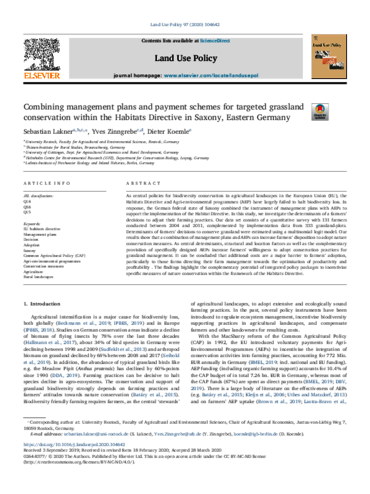As central policies for biodiversity conservation in agricultural landscapes in the European Union (EU), the Habitats Directive and Agri-environmental programmes (AEP) have largely failed to halt biodiversity loss. In response, the German federal state of Saxony combined the instrument of management plans with AEPs to support the implementation of the Habitat Directive. In this study, we investigate the determinants of a farmers’ decisions to adjust their farming practices. Our data set consists of a quantitative survey with 131 farmers conducted between 2004 and 2011, complemented by implementation data from 333 grassland-plots. Determinants of farmers’ decisions to conserve grassland were estimated using a multinomial logit model. Our results show that a combination of management plans and AEPs can increase farmers’ disposition to adopt nature conservation measures. As central determinants, structural and location factors as well as the complementary provisiion of specifically designed AEPs increase farmers’ willingness to adopt conservation practices for grassland management. It can be concluded that additional costs are a major barrier to farmers’ adoption, particularly to those farms directing their farm management towards the optimisation of productivity and profitability . The findings highlight the complementary potential of integrated policy packages to incentivise specific measures of nature conservation within the framework of the Habitats Directive.
Combining management plans and payment schemes for targeted grassland conservation within the Habitats Directive in Saxony, Eastern Germany
Rezensierter Artikel

Lakner, S., Zinngrebe, Y., Koemle, D. (2020). Combining management plans and payment schemes for targeted grassland conservation within the Habitats Directive in Saxony, Eastern Germany. Land Use Policy, 97, 104642
Veröffentlicht
: 2020
Erschienen in
: Land Use Policy, 97, 104642
